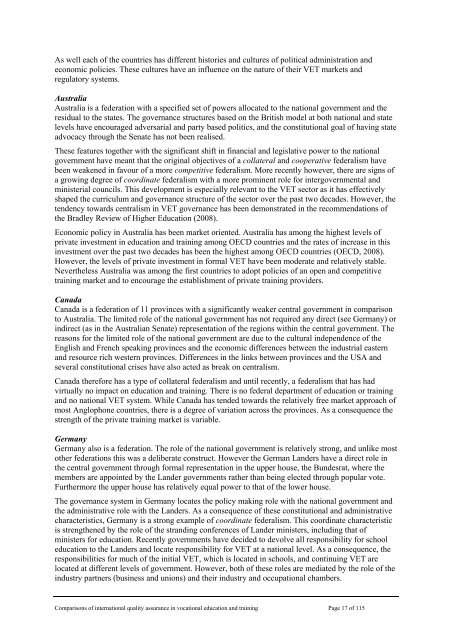Review - Department of Innovation, Industry, Science and Research
Review - Department of Innovation, Industry, Science and Research
Review - Department of Innovation, Industry, Science and Research
You also want an ePaper? Increase the reach of your titles
YUMPU automatically turns print PDFs into web optimized ePapers that Google loves.
As well each <strong>of</strong> the countries has different histories <strong>and</strong> cultures <strong>of</strong> political administration <strong>and</strong><br />
economic policies. These cultures have an influence on the nature <strong>of</strong> their VET markets <strong>and</strong><br />
regulatory systems.<br />
Australia<br />
Australia is a federation with a specified set <strong>of</strong> powers allocated to the national government <strong>and</strong> the<br />
residual to the states. The governance structures based on the British model at both national <strong>and</strong> state<br />
levels have encouraged adversarial <strong>and</strong> party based politics, <strong>and</strong> the constitutional goal <strong>of</strong> having state<br />
advocacy through the Senate has not been realised.<br />
These features together with the significant shift in financial <strong>and</strong> legislative power to the national<br />
government have meant that the original objectives <strong>of</strong> a collateral <strong>and</strong> cooperative federalism have<br />
been weakened in favour <strong>of</strong> a more competitive federalism. More recently however, there are signs <strong>of</strong><br />
a growing degree <strong>of</strong> coordinate federalism with a more prominent role for intergovernmental <strong>and</strong><br />
ministerial councils. This development is especially relevant to the VET sector as it has effectively<br />
shaped the curriculum <strong>and</strong> governance structure <strong>of</strong> the sector over the past two decades. However, the<br />
tendency towards centralism in VET governance has been demonstrated in the recommendations <strong>of</strong><br />
the Bradley <strong>Review</strong> <strong>of</strong> Higher Education (2008).<br />
Economic policy in Australia has been market oriented. Australia has among the highest levels <strong>of</strong><br />
private investment in education <strong>and</strong> training among OECD countries <strong>and</strong> the rates <strong>of</strong> increase in this<br />
investment over the past two decades has been the highest among OECD countries (OECD, 2008).<br />
However, the levels <strong>of</strong> private investment in formal VET have been moderate <strong>and</strong> relatively stable.<br />
Nevertheless Australia was among the first countries to adopt policies <strong>of</strong> an open <strong>and</strong> competitive<br />
training market <strong>and</strong> to encourage the establishment <strong>of</strong> private training providers.<br />
Canada<br />
Canada is a federation <strong>of</strong> 11 provinces with a significantly weaker central government in comparison<br />
to Australia. The limited role <strong>of</strong> the national government has not required any direct (see Germany) or<br />
indirect (as in the Australian Senate) representation <strong>of</strong> the regions within the central government. The<br />
reasons for the limited role <strong>of</strong> the national government are due to the cultural independence <strong>of</strong> the<br />
English <strong>and</strong> French speaking provinces <strong>and</strong> the economic differences between the industrial eastern<br />
<strong>and</strong> resource rich western provinces. Differences in the links between provinces <strong>and</strong> the USA <strong>and</strong><br />
several constitutional crises have also acted as break on centralism.<br />
Canada therefore has a type <strong>of</strong> collateral federalism <strong>and</strong> until recently, a federalism that has had<br />
virtually no impact on education <strong>and</strong> training. There is no federal department <strong>of</strong> education or training<br />
<strong>and</strong> no national VET system. While Canada has tended towards the relatively free market approach <strong>of</strong><br />
most Anglophone countries, there is a degree <strong>of</strong> variation across the provinces. As a consequence the<br />
strength <strong>of</strong> the private training market is variable.<br />
Germany<br />
Germany also is a federation. The role <strong>of</strong> the national government is relatively strong, <strong>and</strong> unlike most<br />
other federations this was a deliberate construct. However the German L<strong>and</strong>ers have a direct role in<br />
the central government through formal representation in the upper house, the Bundesrat, where the<br />
members are appointed by the L<strong>and</strong>er governments rather than being elected through popular vote.<br />
Furthermore the upper house has relatively equal power to that <strong>of</strong> the lower house.<br />
The governance system in Germany locates the policy making role with the national government <strong>and</strong><br />
the administrative role with the L<strong>and</strong>ers. As a consequence <strong>of</strong> these constitutional <strong>and</strong> administrative<br />
characteristics, Germany is a strong example <strong>of</strong> coordinate federalism. This coordinate characteristic<br />
is strengthened by the role <strong>of</strong> the str<strong>and</strong>ing conferences <strong>of</strong> L<strong>and</strong>er ministers, including that <strong>of</strong><br />
ministers for education. Recently governments have decided to devolve all responsibility for school<br />
education to the L<strong>and</strong>ers <strong>and</strong> locate responsibility for VET at a national level. As a consequence, the<br />
responsibilities for much <strong>of</strong> the initial VET, which is located in schools, <strong>and</strong> continuing VET are<br />
located at different levels <strong>of</strong> government. However, both <strong>of</strong> these roles are mediated by the role <strong>of</strong> the<br />
industry partners (business <strong>and</strong> unions) <strong>and</strong> their industry <strong>and</strong> occupational chambers.<br />
Comparisons <strong>of</strong> international quality assurance in vocational education <strong>and</strong> training Page 17 <strong>of</strong> 115
















